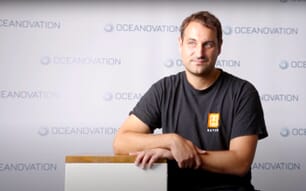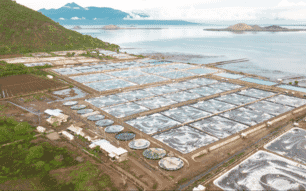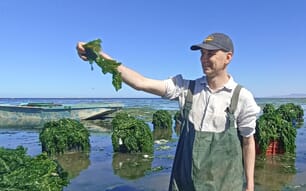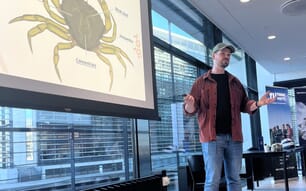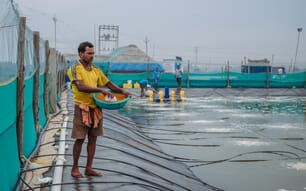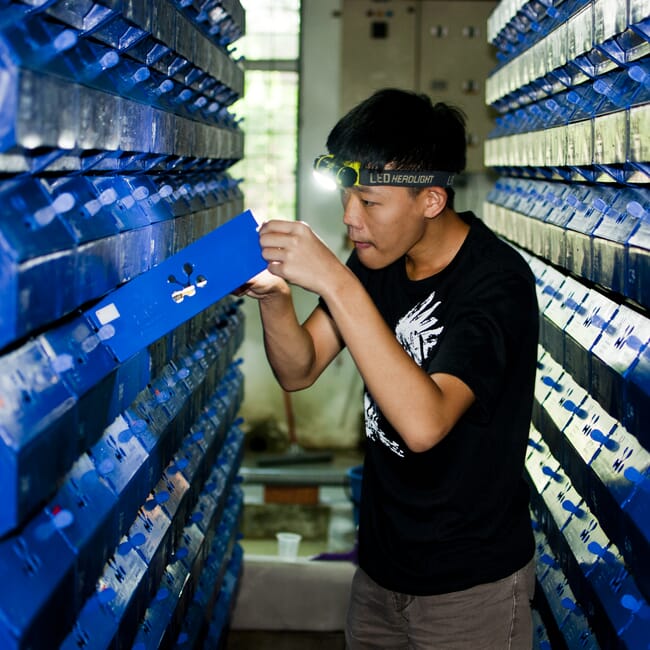
Tung operates an indoor biofloc farm 100 km inland as well as traditional earthen ponds on the coast of Malaysia, producing 15-20 tonnes of both vannamei shrimp and mud crab each year. Of the five years since his farms were established, 2023 has proved the most testing.
“Feed costs have risen by 13 percent, electricity costs have risen by 22 percent while the shrimp price has fallen by 15 percent, so margins have been tight,” Tung reflects.
Despite these challenges, Tung says his company, RAS Aquaculture, has managed to make a profit.
“It has hurt a lot of shrimp farmers, but if your crop doesn’t have a lot of problems – if you can get 80 percent survival, low FCR – you can still be profitable. But there have been a lot of problems with diseases in conventional systems this year – there has been rain even in the dry season, which led to outbreaks of WSSV [whitespot] in a lot of farms in June, which is a bit weird,” Tung explains.
According to Tung, Malaysia normally has a four-month dry season over the summer months – a time when diseases are limited and it’s possible to stock faster-growing specific pathogen tolerant (SPT) shrimp strains. Meanwhile during the monsoon – from October to January – most farmers switch to slower growing, but more robust specific disease resistant (SPR) strains from Latin America. However, because of the high rainfall in June and July of this year, whitespot outbreaks were more prevalent than usual in these months and Tung expects that farmers will consider changing their genetics next summer, in case the same thing happens again.
The combination of low prices, higher costs and lower survival rates have, Tung explains, led to many Malaysian farmers – in particular those who only started farming during the time of high prices that followed the Covid pandemic – dropping out of the sector and returning to their original businesses.
“During 2019-2022 a lot of businesses, for example construction, moved into aquaculture because they thought it was recession-proof and invested in high tech farms. But now a lot of these farms aren’t operational,” he explains.
“But those who’ve been in production since way before the Covid period and have always seen farming as their core business are continuing,” he adds.
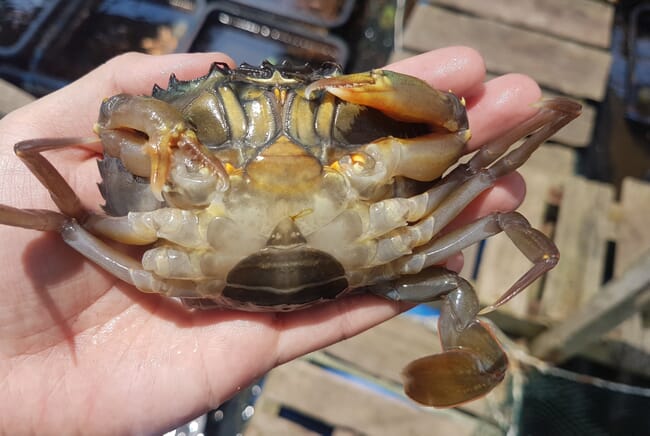
2023 has been a particularly tough year for crab farmers, with high inflation prices meaning people cut back on spending on luxury items like crab © RAS Aquaculture
A crab farmer’s conundrum
While shrimp prices might have dominated the news this year, it’s been even tougher for crab farmers, who tend to sell their produce direct to restaurants, according to Tung.
“High inflation means that most peoples’ disposable incomes have dropped and they are spending less on luxury items like crabs. While shrimp are $5-6 per kilo, crabs are four to five times the price, so crab farmers have been hurt even more than shrimp farmers,” he explains.
“A silver lining for us is that we have always sold our crab direct to restaurants and we’re now selling our shrimp direct to restaurants and as bait for sports fishers too. While most big farms sell their whole crop on ice to a distributor for export, smaller farmers like us have been adjusting and selling their shrimp live in small volumes to specialist outlets and we’ve been able to set up long-term agreements with them and tailor our production to their specific requirements. I think this will continue into 2024 and should ensure that we get better prices,” he adds.
As a result Tung is now selling 60 percent of his shrimp fresh and 40 percent live.
“Going forward we want to form long-term partnerships with all the people looking for live shrimp and grow with them,” he explains.
And he thinks that this will be doubly important thanks to changes in the shrimp trade across Southeast Asia.
“When the Chinese market becomes sluggish a lot of Vietnamese and Indonesian product will be frozen and sent to Malaysia, because our prices are higher. In the past consumers didn’t rush to buy frozen products but now, in the B2B market, because they are pressed for margins are buying frozen shrimp from these countries as they’re much cheaper, even once you’ve factored in import and cold chain costs. Labour, electricity and land costs are all much higher in Malaysia,” Tung explains.
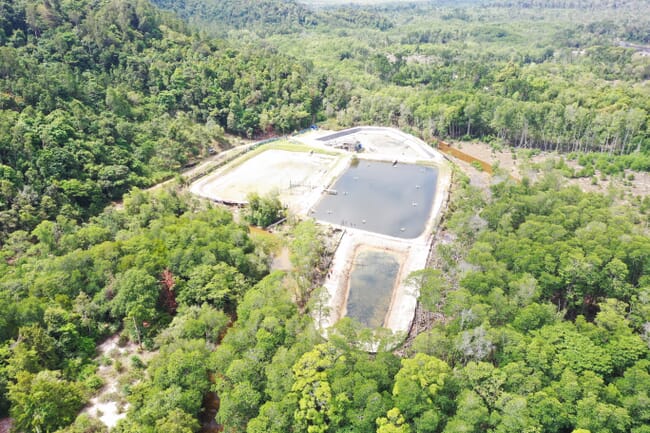
Tung set up an outdoor farm in the hope of making better profits compared to the higher production costs of running his indoor biofloc farm © RAS Aquaculture
However, he notes that the Philippines is the one country in Asia that’s bucking the trend – with shrimp prices remaining relatively high.
“In the Philippines retail and B2B customers prefer fresh products, not frozen ones, so the vannamei sector is still booming there,” he reflects.
Tung decided to hedge his bets a few years ago and set up an outdoor farm in the hope of making better profits.
“My indoor site has a higher cost of production, because of intensity, so my profit margins are lower. In the outdoor ponds my profit margins can be huge but so is the risk. It’s a tough question to know which is the best way. But what I think is important for players who are trying to go down the high tech route for lower profit margins but more consistent production is to look for specialised distribution,” he suggests.
Looking ahead
Tung says that RAS Aquaculture has had quite a good year, despite the challenges, and has been able to expand the team to around 15 people, including those operating farming ventures jointly with his firm.
“We work with a few companies who look for us to provide technical knowhow, in terms of designing farms, and some we co-run together too. It’s very capital-intensive to build a meaningful farm, so working with the right partners is very important. And I think we can continue to expand if we are able to secure enough long-term contracts with specific partners,” he reflects.

An area of his business Tung is looking to expand is the sale of live shrimp © RAS Aquaculture
One of the routes he’s looking to expand on is the sale of live shrimp outside supermarkets.
“This year we tried something quite fun – we packed a lot of live shrimp into a trucks and drove them to a chain of organic supermarkets. It meant that the supermarkets didn’t need to invest in additional infrastructure and they don’t need to worry about spoilt goods, but they get a cut of our sales. We’re not doing it every day but I like this model and I think we’ll continue to do it,” Tung explains.
He also aims to analyse the last 18 months of production data from his indoor farm and see if he can pare down his production costs.
“FCRs are good – we’re close to 1.3 – survival is consistently 80-85 percent, so there’s not much we can cut there apart from building our own feed mill. So we’re looking at new engineering solutions to help bring down manpower and reduce electricity consumption. Our main energy cost is aeration and so we’re looking at smarter aeration designs. And I think that, as we have a fully closed loop system, we might be able to run a programme without sensors. Sensors require a lot of capex and also maintenance costs. A lot of sensors measure things that I don’t need to measure, while there aren’t many sensors that actually measure the things I need to measure,” Tung reflects.
He hopes that such cost-cutting measures – combined will their growing customer base – will help the company realise its ambition to increase production by buying or building additional farms. And also potentially trialling an alternative production system.
“We want to look at a bit of a hybrid system and use our indoor knowledge to create a semi-closed loop coastal farm. It will be good to have access to raw seawater. We will still have to treat it, but it’s better than having to formulate everything on your own. Part of the reason why our power costs in the indoor farm are so high is that we are doing all this water recirculation and recycling,” Tung reflects.
In terms of his crab production, Tung intends to sell small, softshell crabs.
“I worry for the big crab market. I’ve spoken to a lot of restaurants that specialise in jumbo crabs. Although this year and next year they might be able to sell jumbo crabs, that’s not likely to be the case in 10 years from now, as the economics of growing big crabs don’t work. Just like tilapia – the optimal size is half a kilo, anything beyond that has very high production costs. So we’re trying to stick to selling crabs at 300-500 g apiece, we have a farm dedicated to softshell crab production and we’re trying to slowly change our customers so that they look to smaller crabs that are easier to farm – either we improve the technology, which is very difficult, or we change the market. I think that changing the market is more possible because consumers don’t have a choice,” Tung notes.
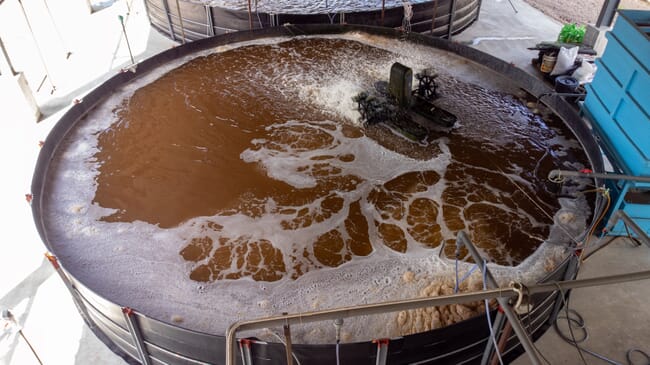
Tung aims to analyse the last 18 months of production data from his indoor biofloc farm and see if he can pare down his production costs © RAS Aquaculture
Wider trends
Looking at the wider Malaysian aquaculture sector, Tung fears that 2024 might be even more testing than the year that’s now coming to a close.
“From the looks of it the first quarter of 2024 will probably be even harder. I’m worried that some of the hatcheries I work with haven’t been buying as many broodstock and won’t have enough volumes. And if it starts to get too low it could have a chain reaction and leave a shortage of inputs,” he suggests.
“Another worry is that I think a lot of recent investors in high intensity shrimp farms won’t get through this period of low prices and I fear that fewer people will want to invest in the aquaculture industry more generally,” he adds.
This is likely to impact service providers in Malaysia too, as the aquaculture ecosystem is comparatively small.
“If there’s a bad year suddenly your whole farming co-op can disappear. It can take so long to build the value chain but it can be destroyed overnight. It’s something I’ve seen already starting in Singapore and Malaysia – all these high tech farms are starting to crumble away,” Tung concludes.


